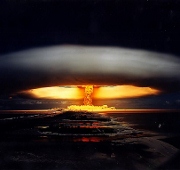The weapons of war must be abolished before they abolish us – John F. Kennedy (UN Speech 1961)
Imagine: A possible atomic bomb detonation over the heart of Islamabad. Little Boy, the first Uranium bomb used in war by US on Hiroshima will result in a mighty conflagration that will melt concrete, reduce vehicles to charred craters and the air will be thick with blinding smoke and the acrid stench of burning flesh. Tsar Bomba, the most powerful nuclear weapon ever detonated by the USSR, will reduce the twin cities to a crumbling, fiery mass of debris. Inhabitants of areas up to Haripur and Wah will suffer from first and second degree burns. The massive mushroom cloud will be visible from a radius of 160 km and its crown will cast an ominous shadow on the blazing city below. Each one of us will be in the thick of Ground Zero.
On August 6th 1945, the world was introduced for the first time to the devastating horror of an atomic explosion. The explosion ended a lengthy war – the cost paid by over 100, 000 Japanese civilians with their lives. Since then the world has been haunted with the possibility of another nuclear warfare or worse, the access of nukes by terrorist groups – resulting in a nuclear catastrophe possibly leading to a global wipeout.
In past 20 years, at least 25 instances of nuclear weapons theft have come to surface. The world currently contains enough highly enriched uranium (HEU) to build 100, 000 nuclear bombs – a single nuclear arsenal, which can explode with the energy of 13 to 18 kilotons of TNT can wipe out a population of 150, 000. 100, 000 such weapons can kill up to 15 billion people – twice the population of the world. 29 countries today have over 23, 000 nuclear weapons and 40 countries across the globe possess nuclear material that can be the likely target of theft by terrorist organisations.
These startling numbers represent stark realities and threats of the most powerful weapon in the world. Since the sophistication of the Manhattan Project is no longer required to develop a nuclear bomb, the complete elimination of nuclear arsenal needs to be the topmost agenda of global diplomatic discussions on peace. A world without nuclear weapons is no longer the dream of an idealist, but the need of the hour – an imperative step to survive an impending disaster.
A vital first step has already been taken by the two countries that possess 96 percent of the world’s nuclear stockpile. U.S. President Obama and Russian President Dmitry Medvedev have signed an agreement to reduce the strategic missile launchers to half. The path has been defined and the goal is clear – a complete nuclear lockdown in the coming years: global zero.
The Countdown to Zero has already begun with the international movement Global Zero initiated in December 2008 and gaining international momentum. With backing from world leaders and key players in global decision making Global Zero is working for the phased and step-by-step elimination of nuclear weapons worldwide. The UN Secretary General Ban Ki-moon has strongly endorsed the movement, “My vision at this time is clearly to realize a world free of nuclear weapons”.
Garnering international media attention, Global Zero is slowly and methodically inching towards its goal. With 300 world leaders supporting the movement and the Obama administration declaring its support, the groundwork has been laid and the coming decades might witness the realisation of a world free of nuclear weapons.




